2021
I had forgotten to buy Stevia seed so I really hoped the four overwintered
plants would live and do well this year. I had dug and put them in large pots in
the fall, and they again did fine in the greenhouse. The largest was two years
old, the other three planted last year. In the spring they were transplanted
back in the garden in the most upper plot which is less frost prone than the
bottom. Unfortunately, it is also light soil and not as fertile as it has been a
tree and plant nursery plot for some years. But I didn't think the Stevia needed
high fertility. They went out mid May and so got a rough start when the four
night freeze hit a week later. They were covered with blankets but with a low of
22 there was leaf damage. They outgrew it though, and also made it through the
challenging 7 week spring drought.
Then the nearby hot peppers grew large and were overhanging the stevia. But,
like the peppers, they loved the (again) record hot summer and all but the
smallest one grew nicely. They didn't get a lot of attention and it was late
summer when I realized they all had significant leaf hoppers, cared for by their
ants, living in the crotches of the leaves, safely hard to get to. So I spent
some time with soapy water and a paint brush, as well as simply squashing as
many as I could without harming leaves. It worked and the population dwindled
with just a minor loss of leaves. But in spite of a challenging growing season
for them they gave me a large harvest of leaves, which when dried and ground
turned into a pint of sweet powder, enough for my use. It's an amazing plant.
In October I dug three plants into large pots to overwinter in the greenhouse.
This will be the last year for the oldest, three years old, as it is getting too
large. So I will plant fresh seed next year. I might try rooting some cuttings
as well. If that works it would save the most challenging part of growing stevia
-- getting the tiny seedlings to transplant size.
2020
The 2018-19 overwintered plant did OK when transplanted out in
the garden though it wasn't as robust as the new seedlings, so mid-July I cut it
back and it regrew fine. The season was cooler with a wet end of summer and the
plants reflected their desire for more heat. They grew and I got a harvest; it
just wasn't as big as the previous year.
The winter of 2019-20 I again overwintered a plant in the greenhouse and it did
well. Plants left in the garden both years died. The summer of 2020 was a record
season of long and hot, with temps in the low 80's common which is quite unusual
for us cold blooded Yoopers! We sweltered but the Stevia loved it! In early
August the robust plants started flowering, especially the one
overwintered/replanted. I harvested the 6 plants down to the bottom leaves. They
regrew. I harvest all large leaves in early September. Then the end of Sept. the
final harvest, cutting them all down. When dried and ground I had 1 3/4 cups
Stevia powder. This year's result was stronger flavored than the last two years.
Though later in the winter it had mellowed some.
Mid-October I dug up four of the Stevia roots to transplant to the greenhouse
bed when moving things in for the winter. To my surprise, and probably his even
greater surprise, a guest came in with one of the Stevia plants. Here's the
story:
October 14, 2020 When I was lifting one of the
Stevia clumps into its new home in the bed some of the dirt fell off and
out fell a small toad! He had likely dug himself down into the dirt for
the winter and I'm sure this was quite an unwelcome rude awakening. He
is about 1 1/2 inches and a pretty black-white-gray coloring. I quickly
moved him under a recently transplanted parsley with the hopes he will
dig down and re-establish his winter quarters and get back to sleep. It
won't be as cold as out in the garden, but hopefully to his liking.
Addendum: It's 8:00 pm and I just went out
in the greenhouse with a flashlight to close the insulated front
curtain. Might as well keep some of that daytime heat in. As I walked
out I quickly shined the light at the parsley at this end and there
perched on a leaf was the little toad, quite wide awake! I quickly
turned the flashlight away out of his eyes. I'm sure I
moved in plenty of earthworms and likely other garden insects with the
plants but whether there is enough to feed a small toad I don't know.
I'll have to do some research. I may have to move him back out to the
cold but natural habitat garden. Though I certainly wouldn't mind
having a companion toad out there, if he might enjoy it.
October
15, 2020 -- "Toad" update
Off and on during the night I thought about the
toad - would he get in the mousetrap (livetrap), would he jump off the
bed (falling on the very hard stone floor), was there enough for him to
eat, should I have put out a dish of water, should I put him back
outside ... A litany that did no one any good! In the morning I went
right into the shop and shined a light through the 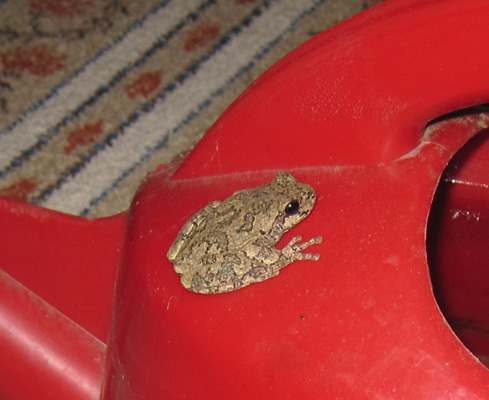 window into the
greenhouse and there he was, sitting on the wood sill near the parsley,
looking east out the window, waiting for the sun to come up? I went out
to talk to him about moving back to the garden. When I stepped into the
greenhouse he hopped up on the side of the nearby small plastic watering
can, having no trouble hanging on. Oh... Steve came out just then with
the comment that toads don't do that. Yeah, I know. My only excuse is
that I expected a toad and never looked any closer (though you'd think
the coloring would have given me a clue!). I've seen a lot of toads in
the garden but never a tree frog. It didn't occur to me that one might
decide to hibernate there, though it certainly is easy digging. But Tree
Frog he/she certainly is, and a handsome cute one at that. Obviously quite
awake I quickly scooped him up as he hopped to the top of the watering
can and I worried he might hop into the water. We headed out to the
garden and I set him down in the newly planted garlic patch with lots of
mulch, freshly dug soft dirt, and no one digging in there until next
fall. He calmly hopped off my hand, in no big hurry, and surveyed his
newest surroundings. Thankfully there is plenty of time for him to
re-hibernate before the really cold weather sets in. I think we'll both
sleep better tonight. window into the
greenhouse and there he was, sitting on the wood sill near the parsley,
looking east out the window, waiting for the sun to come up? I went out
to talk to him about moving back to the garden. When I stepped into the
greenhouse he hopped up on the side of the nearby small plastic watering
can, having no trouble hanging on. Oh... Steve came out just then with
the comment that toads don't do that. Yeah, I know. My only excuse is
that I expected a toad and never looked any closer (though you'd think
the coloring would have given me a clue!). I've seen a lot of toads in
the garden but never a tree frog. It didn't occur to me that one might
decide to hibernate there, though it certainly is easy digging. But Tree
Frog he/she certainly is, and a handsome cute one at that. Obviously quite
awake I quickly scooped him up as he hopped to the top of the watering
can and I worried he might hop into the water. We headed out to the
garden and I set him down in the newly planted garlic patch with lots of
mulch, freshly dug soft dirt, and no one digging in there until next
fall. He calmly hopped off my hand, in no big hurry, and surveyed his
newest surroundings. Thankfully there is plenty of time for him to
re-hibernate before the really cold weather sets in. I think we'll both
sleep better tonight.
Back in the greenhouse ...
In a month or two those four plants started regrowing and had small leaves most
of the winter. In the spring they started growing in earnest and when the sun
was no longer hitting the back of the bed by the house where they were I
transplanted them to the largest clay pots I had so they could move nearer the
windows. They are doing fine but I think next year I'll transplant them from the
garden right into larger pots and just sink the pots in the bed so there is less
root trauma. Though I can't say as they've shown any sign of stress. It is just
the end of April now so it is probably six weeks before they can safely go out
in the garden (we're still having freezing nights). But they seem to be enjoying
spring right where they are, and I can enjoy a sweet nibble now and then when
working in the fast growing greenhouse.
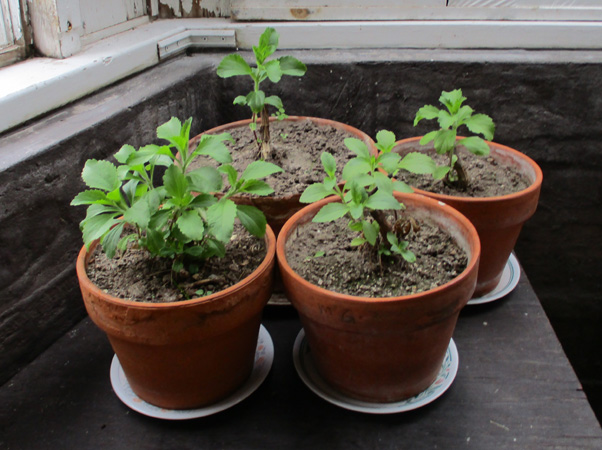
January 22, 2019 --
Stevia, a Sweet Report
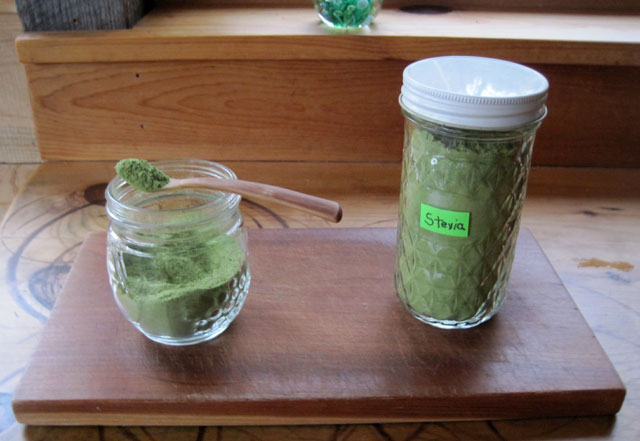 I
grew some stevia this past season for the first time, a mild interest
that caused me to add it to my Fedco seed order at the last minute. I’d
read that it was hard to grow from seed and likely needed a warmer
climate than here but I decided to give it a try anyway. I
grew some stevia this past season for the first time, a mild interest
that caused me to add it to my Fedco seed order at the last minute. I’d
read that it was hard to grow from seed and likely needed a warmer
climate than here but I decided to give it a try anyway.
Planted in the quite cool greenhouse the end of
February, along with peppers and a few other early crops, the stevia was a
real slow grower. By early April I only had three tiny plants to transplant
into small pots. They looked pretty iffy but they hung in there and made
some growth by the time all the plants made the big move into the garden the
end of May. I put the three small seedlings at the far end of a plot, with
care but also a bit of doubt as to their surviving.
Well, they not only survived, they thrived. We had
an unusually long, hot summer and did they love that. They got the usual
care, mulch and a few words of encouragement but not anything special. To my
surprise they grew healthy, hearty and strong - an attractive well leafed
light green plant. Unfortunately I didn’t take a photo of them in all their
glory. They don’t stand out a lot, just quite nice. Every once in awhile I’d
pick a little piece of leaf for a nibble. It was such a strange sensation to
see this green leaf and expect some sort of "leaf" flavor but instead get a
very, very sweet taste. Even if I didn’t do anything else I figured that it
was a success -- a bit of fun in the garden.
In early September they were about two feet tall and
almost as wide. The trio filled up their 4 ft of space quite well without
being too crowded. I picked the largest leaves to dry and got quite a
harvest from just those three plants. I left quite a bit of growth to keep
feeding the roots in the chance they might make it through the winter,
though most reports say that isn’t likely with our cold winters.
Articles often compare growing stevia to growing
basil, a plant that starts wilting if one even mentions the chance of frost,
no matter how light. Well, early September was very warm but soon cooled off
with a number of light frosts in the 30 degree range. I harvested a last
large picking of basil (they also loved the unusually hot summer) before
those frosts finished it off. But the stevia plants weren’t fazed in the
least; they just kept growing.
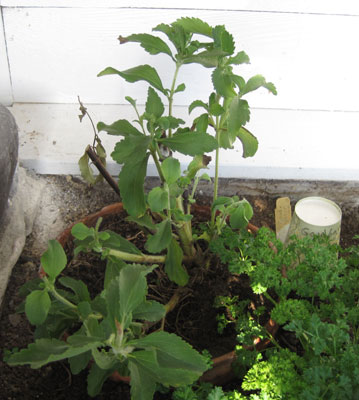 Towards
the end of September I cut the still green plants down to about 7", hanging
the much leafed cuttings in the house to dry. More harvest. The plants
regrew. A harder frost of 27 degrees didn’t cause any damage. But I decided
to pot up one of the plants to overwinter in the greenhouse before it got
any colder. I had to cut off a LOT of root to do so, snugging it into a 10"
inch clay pot. It moved into the greenhouse in mid October in good form
before the temps fell into the teens. A hard freeze did finally put the
outside stevia plants into winter dormant mode but they are obviously of
much hardier stock than basil. Towards
the end of September I cut the still green plants down to about 7", hanging
the much leafed cuttings in the house to dry. More harvest. The plants
regrew. A harder frost of 27 degrees didn’t cause any damage. But I decided
to pot up one of the plants to overwinter in the greenhouse before it got
any colder. I had to cut off a LOT of root to do so, snugging it into a 10"
inch clay pot. It moved into the greenhouse in mid October in good form
before the temps fell into the teens. A hard freeze did finally put the
outside stevia plants into winter dormant mode but they are obviously of
much hardier stock than basil.
Surprisingly, the butchered roots and rather rude
transplant into a pot didn’t seem to affect the greenhouse plant at all. No
lost leaves, no yellowing, no wilting in spite of losing probably half its
roots. It did have a few flower buds that I nipped off and it continued with
some more growth. At the end of December it was still alive and I’ve
harvested a leaf now and then to put in tea or dinner. But now in mid
January it is starting to look like it’s ready for a rest with some
browning/yellowing of some leaves. It’s time to ease off on watering and let
it hibernate. We’ve had some significant below zero cold spells this month
and the greenhouse is often near freezing. It will be quite interesting to
see how this one does and if the overwintered plants in the garden survive.
That’s asking quite a bit of a plant native to Brazil and Paraguay! I plan
to start new plants from seed in the spring anyway.
HARVEST - Now back to all those drying leaves. It
was a much larger harvest than I expected. The leaves stayed nicely green
(many herbs, including basil, darken when dried, even air-dried as mine
are). I ground them to a powder with a steel-bur mill and got a full pint of
finely powdered herb. There is no doubt that stevia has a taste of its own
but we both like it. I don’t consider it a substitute for sugar, just
another option. Since we don’t use white sugar (except in wine) we’re used
to stronger tasting sweeteners anyway -- Sucanet, honey, maple syrup.
The dried powder is easy and handy to add to morning
oatmeal/fruit sauce, or plain applesauce, yoghurt if it's the non-sweetened
kind. I used many fresh leaves in tomatoes when canning
them and also for sweetening grape juice (steam processed). It worked well
for both and I’ll probably make more use of it fresh next year. The biggest
challenge I’ve had is guesstimating how much is enough. You
definitely don’t want to overdo it. So I add a small amount, then taste,
then add more if needed. I particularly like the flavor in tomato dishes and
other meals that need just a bit of sweetening without a sugar taste. I’m
beginning to get a feel for how much is enough and have started replacing
half the honey or Sucanet in cookies with stevia. It's a winner there, too.
I'll have to grow more though to use it that way often.
There is a bit of a down side to home-grown ground
stevia. There’s no getting around that it is ‘green’. It just plain looks a
little, well, strange, on your oatmeal or applesauce. But one gets
used to it. Add some cinnamon and it just blends to a slightly
different, and tasty, shade of brown. We are used to brown Sucanet so it’s not really all
that much different, and I tend to think very light colored applesauce is a
bit suspect anyway. Sort of like white bread when you’re used to whole
grain.
So stevia was a surprisingly easy and successful
trial here on the homestead. It won’t replace sugar (or Sucanet in our case)
or honey but it doesn’t have to. It can just be itself, and I appreciate it as it is.
Copyright
© Susan Robishaw
|
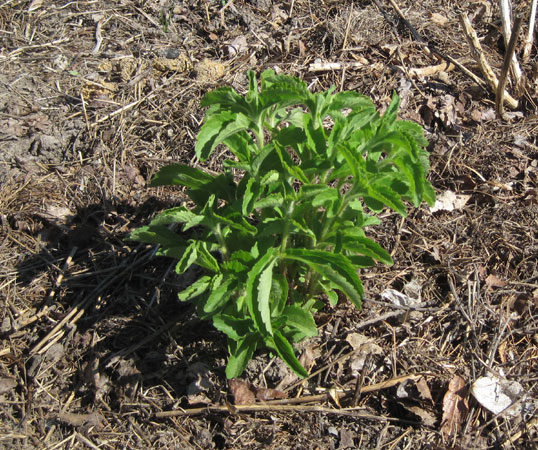



 window into the
greenhouse and there he was, sitting on the wood sill near the parsley,
looking east out the window, waiting for the sun to come up? I went out
to talk to him about moving back to the garden. When I stepped into the
greenhouse he hopped up on the side of the nearby small plastic watering
can, having no trouble hanging on. Oh... Steve came out just then with
the comment that toads don't do that. Yeah, I know. My only excuse is
that I expected a toad and never looked any closer (though you'd think
the coloring would have given me a clue!). I've seen a lot of toads in
the garden but never a tree frog. It didn't occur to me that one might
decide to hibernate there, though it certainly is easy digging. But Tree
Frog he/she certainly is, and a handsome cute one at that. Obviously quite
awake I quickly scooped him up as he hopped to the top of the watering
can and I worried he might hop into the water. We headed out to the
garden and I set him down in the newly planted garlic patch with lots of
mulch, freshly dug soft dirt, and no one digging in there until next
fall. He calmly hopped off my hand, in no big hurry, and surveyed his
newest surroundings. Thankfully there is plenty of time for him to
re-hibernate before the really cold weather sets in. I think we'll both
sleep better tonight.
window into the
greenhouse and there he was, sitting on the wood sill near the parsley,
looking east out the window, waiting for the sun to come up? I went out
to talk to him about moving back to the garden. When I stepped into the
greenhouse he hopped up on the side of the nearby small plastic watering
can, having no trouble hanging on. Oh... Steve came out just then with
the comment that toads don't do that. Yeah, I know. My only excuse is
that I expected a toad and never looked any closer (though you'd think
the coloring would have given me a clue!). I've seen a lot of toads in
the garden but never a tree frog. It didn't occur to me that one might
decide to hibernate there, though it certainly is easy digging. But Tree
Frog he/she certainly is, and a handsome cute one at that. Obviously quite
awake I quickly scooped him up as he hopped to the top of the watering
can and I worried he might hop into the water. We headed out to the
garden and I set him down in the newly planted garlic patch with lots of
mulch, freshly dug soft dirt, and no one digging in there until next
fall. He calmly hopped off my hand, in no big hurry, and surveyed his
newest surroundings. Thankfully there is plenty of time for him to
re-hibernate before the really cold weather sets in. I think we'll both
sleep better tonight.
 I
grew some stevia this past season for the first time, a mild interest
that caused me to add it to my Fedco seed order at the last minute. I’d
read that it was hard to grow from seed and likely needed a warmer
climate than here but I decided to give it a try anyway.
I
grew some stevia this past season for the first time, a mild interest
that caused me to add it to my Fedco seed order at the last minute. I’d
read that it was hard to grow from seed and likely needed a warmer
climate than here but I decided to give it a try anyway.  Towards
the end of September I cut the still green plants down to about 7", hanging
the much leafed cuttings in the house to dry. More harvest. The plants
regrew. A harder frost of 27 degrees didn’t cause any damage. But I decided
to pot up one of the plants to overwinter in the greenhouse before it got
any colder. I had to cut off a LOT of root to do so, snugging it into a 10"
inch clay pot. It moved into the greenhouse in mid October in good form
before the temps fell into the teens. A hard freeze did finally put the
outside stevia plants into winter dormant mode but they are obviously of
much hardier stock than basil.
Towards
the end of September I cut the still green plants down to about 7", hanging
the much leafed cuttings in the house to dry. More harvest. The plants
regrew. A harder frost of 27 degrees didn’t cause any damage. But I decided
to pot up one of the plants to overwinter in the greenhouse before it got
any colder. I had to cut off a LOT of root to do so, snugging it into a 10"
inch clay pot. It moved into the greenhouse in mid October in good form
before the temps fell into the teens. A hard freeze did finally put the
outside stevia plants into winter dormant mode but they are obviously of
much hardier stock than basil.